Digging around in my pantry looking for dinner inspiration, I unearthed several heads of garlic wishing they had a place to grow! Garlic is an allium. Alliums don’t grow when days are short and nights are long, but, when spring comes and days lengthen, alliums spring into action. We are often told when garlic or onions sprout in late winter or early spring that they are inedible and should be discarded. Sprouted garlic and onions may not be at their peek of desirability for eating, but they are perfect for planting in a container for an April to June crop of savory, garlicky greens.
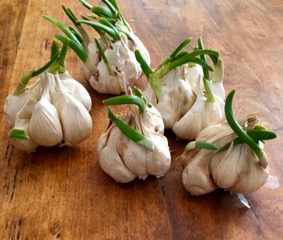
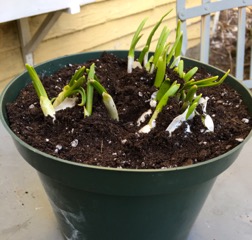
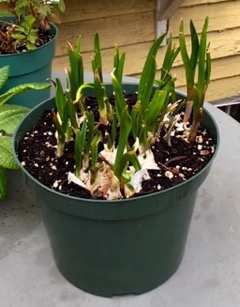
This garlic is ready to grow for greens! The garlic sprouts will straighten up and grow 12 or more inches tall if planted in a container filled with good potting soil, watered well and put in a sunny kitchen window or outdoors in a sunny spot after nights warm to about 30 degrees. Alliums are tough plants, happy to grow in colder temperatures as long as the days are long enough. It’s the lengthening daylight hours that get them growing. Plant whole heads or individual cloves with the green sprouts pointing up. Push the heads, or cloves, about half way down into the soil and water well. That’s all you need to do. I planted whole heads in this plastic pot filled with fresh potting soil. After watering, I put the pot on a south-facing table outside our backdoor. Two weeks later, I began cutting fresh, mild tasting garlic greens for salads and garnishes.
In this larger pot, also outside our back door, I planted a mix of single cloves and whole heads of garlic. It doesn’t get quite as much sun as the table, so the garlic will grow more slowly. Two weeks later, the garlic is growing nicely with some viola tricolor. When warm summer weather arrives in mid-June, cut what is left of the greens, pull the plants out of the containers and put them in the compost pile. Add some fresh compost to your containers and plant something else. It's time for the next great crop!
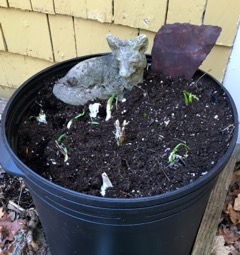
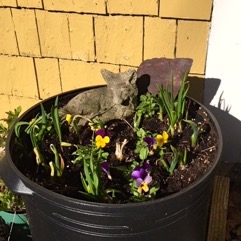
APRIL IS ONION PLANTING MONTH
Onions, another member of the allium family, are easy to grow. Instead of starting onions from seed, purchase onion sets from a local garden center, as they all have them for sale right now. An onion set is an 1 inch sized onion bulb ready to grow. They usually come 50 to a package with a choice of either yellow, red or white onions and are inexpensive to buy. Like most vegetables, onions need at least 6 hours of sun per day, excellent drainage, well composted soil and regular watering to thrive. Onions don’t take much room to grow--a four foot by four foot raised bed will yield 65-70 onions. Plant the sets about 6 inches apart in rows 18 inches apart.
When daylight hours begin to shorten in mid-August, onions signal they are ready for harvest. Their tall green leaves begin to yellow and the strong tops fall over. Pull them from the soil and spread the bulbs out in a warm, dark spot with good air circulation to cure for two weeks. (I cure mine in the garage). At the end of two weeks, trim the tops and roots of each onion and store them in mesh bags or open baskets to enjoy all fall!
HAVING PROBLEMS ORDERING SEEDS? WHAT ABOUT LEFTOVER SEEDS?
The coronavirus quarantine has created a sharply increased interest in gardening, especially vegetable gardening. As a result, many seed companies are running out of retail seed packets, a new experience for most of them. If you’ve tried to order seed online or through a catalog and have not been successful, most local garden centers and many hardware stores carry seed. Call them up. Many are willing to mail you seeds or are happy to do curbside pick-up for prepaid orders if you are uncomfortable going into the store.
If you have seed left over from last year, either in the original packet or seed you collected, don’t hesitate to plant that seed. Many seeds stay viable for 3-4 years, some much longer. High Mowing Seed Company has an excellent viability chart. If you can’t remember how old the seed in that half-used packet is, read the packet carefully. The year it was packaged has to be printed on the packet by law. The germination rate of seed declines each year but usually some of the seed will germinate and produce healthy, vigorous plants. --Betsy Williams
